Carol and Billie
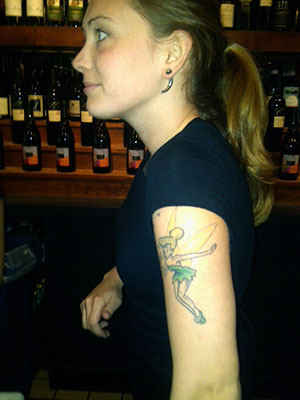
(Tinker Belle and her distinctive ink behind the bar at Willow).
Tinker Belle was serving the drinks behind the Willow’s long bar when I came in off the street. Admiral Mac Showers had already arrived, and I brightened when I saw that he was permitting himself an Anchor Steam beer, which meant that his session with the oncologists had a positive outcome that week. I like Tinker Belle- she is from New Orleans and we laugh about the Cajun antics we have seen down there, and the joy their bring to their culinary art. In fact, Tink might be my favorite Willow bartender except for Liz-with-an-S, whose intelligent banter, chestnut hair and slim elegant neck make her as vital a feature at the bar as the alcohol. Almost.
I was not at all focused on the discussions with Mac. I vaguely wanted to get to the Vietnam Era, since I worked a project about the period that I still cannot fully unravel. But as with all these discussions, I decided to just see where it wandered on its own. I swear sometimes the Willow acts like a time machine, or the spinning circle from the Wheel of Fortune. This languid afternoon we landed in 1962, as Mac talked about some of the people he worked with in the Special Intelligence Branch of the Office of Naval Intelligence.
“My senior civilian in “Y ” Branch at that time was Ed Nielsen. I had known him since the late ’40s, when he came to work in Y-1, and he and I were long-time friends, and I was comfortable having him as a senior civilian assistant in Y-Branch. We both arrived early in the morning around 0700, we compared our notes, and did our things, almost before other people go to work. It was during this tour, and while working with Ed, that the DeSoto Operations began.”
“Yeah. The traffic is so bad here, and the parking, that I would be in the Pentagon by 0600. You explained about how you named it ‘Desoto,’ beginning with the name of the destroyer that did the surveillance operations and to save characters in the message title line. It was from the destroyer’s name, right? ”
“Right. It was the De Haven (DD-727). I won’t go into that again, but I will say that in a subsequent DeSoto·Operation there was an interesting development. I have not talked a lot about my wife billie and the three kids. We certainly dragged them all over the world, and naturally though the hours were long, we lived in some nice place. So it would have been on the second or third of the collection operations that Ed and I got a chance to give something back to the wives. The operating area was off Shanghai, at the mouth of the Yangtze River. As we developed the collection list, one of the requirements was put on by the Office of Naval Research (ONR) to try to collect water samples out of the Yangtze River to determine whether there were any nuclear activities being conducted upriver that would be detectable from the effluent coming out of the Yangtze off Shanghai. For this purpose, ONR provided two pieces of equipment that the destroyer was going to have to lower into the water to collect water samples in certain places and at certain times.”
“I like Shanghai. I always was fascinated when we took the train in the New Territories in Hong Kong that we could have just stayed on until we crossed the border and ridden on to the exotic and inscrutable East.”
“I don’t think you commanding officer would have approved before the Brits gave Hong Kong back,” said Mac. “But now it is no big deal. Just don’t take your personal computer with you. But for the Yangtze collection mission, there were some
rather complicated instructions from ONR on how to properly operate the complicated pieces of equipment. I remember it because we needed separate but non-descriptive code names for these two pieces of gear so that we again didn’t have a long phrase to describe what we were trying to do.”
“Just like the DeSoto name,” I responded. “Brevity is the soul of elegance. So what did you call them?”
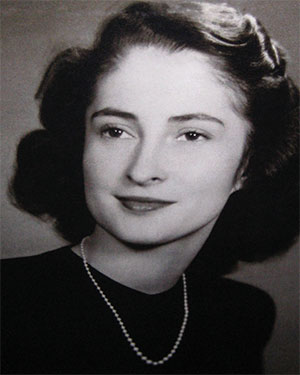
(Mrs. Donald “Mac” Showers, aka “Billie).
“It was simple. We named one piece of equipment “Carol,” after Ed Nielsen’s wife. The other piece was code-named “Billie” for my wife. This DeSoto patrol off Shanghai carried Billie and Carol equipment”.
“And the crews kept lowering them into the water trying to detect atomic effluent corning out of the Yangtze. I don’t think they ever detected any. Later in that tour — it was only a year — Ed Nielsen was replaced by George Kidd. This was Admiral “Rufe” Taylor’s doing. He felt that George Kidd, who was the senior civilian in ONI and had had well-rounded experience in ONI, ought to have experience in OPINTEL, which he had not had. So, Admiral Taylor replaced Ed Nielsen with George Kidd. And as good a friend of mine as George Kidd was, and continued to be, he never really understood and appreciated OPINTEL. And to lose Ed Nielsen and to have to teach George Kidd about OPINTEL, and expect him to function effectively as a senior civilian in the “Y” Branch, was a difficult undertaking.”
“Did Ed stay in “Y” Branch?
“No. I can’t remember where he moved to, but I think he moved up toward the front office because he later became the senior civilian and Technical Assistant to the DNI after I had left.”
“Wait- I actually know the name now. Didn’t they name the annual ONI award for analytic excellence the Nielsen Award?”
“They certainly did. Ed was a smart guy who put in tremendously long hours. A real analytic workhorse, and a unqiue individual. I knew him from the day we hired him until the day he died. He worked hard and always was full of ideas and enthusiasm. He was a delight to have around and be able to depend on. Which rimnds me: During my tour at Y1 we had a remarkable look into how the Soviets really were organized. We got copies of what were called The Penkovsky Papers.”
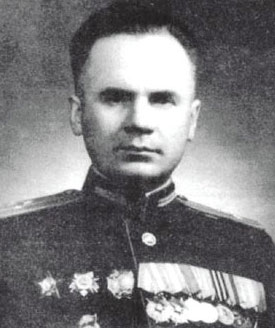
(GRU Colonel Oleg Penkovsky).
“That was a major intelligence coup,” I said, dropping my pen and taking a sip of wine. “Maybe the biggest of the era. Wasn’t Oleg Penkovsky a colonel in Soviet military intelligence- the GRU- and the highest-level Soviet officer to spy for the United States or Great Britain up to that time?”
“Absolutely. It was a trove of material. During his time in uniform, he grew disillusioned with the Soviet regime and wanted to help prevent a nuclear war between the superpowers, so he volunteered to spy for the United States and the United Kingdom.”
“Was he real? There is so much fakery in the HUMINT Business.”
“We thought so. And thus the problem on how to exploit it. Navy got the material from Langley, of course, but they came with the explicit understanding that we could read them but make no attribution to Penkovsky as the source. We could be influenced by them, but we could not compormise sources and methods. That made our problem very difficulrt because of the wealth of information the papers contained. One of the most import things in the papers were the Soviet “Military Thought” articles, which was a classified publication similar to our US Naval institute Proceedings, but more authoritative because it was officially blessed by the Kremlin, and classified in their channels. The articles contained information about Soviet naval tactics and stragey, which represented new trhinking and new things that should hae been made available more widely to our Navy that might have to confront Admiral Gorshkov’s expanding fleet.”
“In World War II didn’t you conceal the information gleaned from Japanese Codes in a low-level classified weekly Fleet Intelligence Bulletin and attribute the information to press reporting or Coast Watchers?”
“Yes, and it worked to protect the source of the information. Ed and I put our heads together and decided to write a “Think Piece” that was not attributed to the Papers. It was written as a speculation that the Soviets would be able to launch a ballistic missile that wouldd impact over a task force with a nuclear warhead. A blassitic missile that could be launched either from shore or from antohr ship or from submarines that would attack a task force at sea.”
“This was 1962 and the Missile Crisis was still on the horizon?”
“Yes. The paper we wrote was classified TOP SECRET and was given to a very limited distribution within the OPNAV Staff. It did go to the OP-03 and 05 crowd, to key offices we felt needed to know about this tactical development. From the source materials, we knew this was not speculation, and it really was something the Soviets planned on adding to their strategy. Of course, we could not say that. All we could do was speculate that this was something the Soviets might do.”
“Oh Lord. Protect the hapless intelligence wienie who tells the senior ship-driver in Acquisition that his ships are all going to get melted by the Godless Commies.”
“Precisely. The E-ring in the Pentagon and the Surface Warfare Community got so upset over our paper that DNI Frost was directed to recall and destroy all copies of the paper and not to pursue the subject further.”
“That wasn’t the end of the matter, though, was it?”
“No. It is still being written about in the open-source literature. As we destroyed our paper, Ed and I regretfully concluded that we were ordered to shred the paper because of the “not invented here” syndrome. And we had to do it, had to comply with the order and destroy all that wonderful analysis.”
“There was no way to get the CIA to reconsider their restriction on the information so you could prove what you had written about?”
“Not then. CIA was unyielding in their security control with the Penkovsky Papers.”
“And the Navy was left vulnerable and exposed to tactics we could not mention, even though we knew.”
“Bingo.”
I sighed. Plus ca change and all that.
Copyright 2017 Vic Socotra
www.vicsocotra.com
Life and Island Times: Trouble Ahead, Trouble Behind

Is there anything a man don’t stand to lose
When the devil wants to take it all away
Cherish well your thoughts, keep a tight grip on your booze
‘Cause thinking and drinking are all I have today
– chorus from the Grateful Dead’s Mexicali Blues
The road had thought differently about the bikers’ plans in the past. From time to time the byways had become a bitchy cognitive dissident. Several times it had snuck up on them and filched their status quo mojo. It nearly killed
them when hail pounded their backs like shotgun blasts. It didn’t give a shit about what lay behind them and what the riders hoped might lie ahead. It forced them again and again to confront what lies within.
They had had a full measure of motorcycle troubles during this voyage. Unlike anytime during the past ten years of riding, mechanical troubles seemed attracted to their bikes like vultures are to a zebra’s carcass. Yes, they had had
trouble so thick that you could add bell peppers and jalapenos and bottle it as salsa.
Steve, Augustus and Marlow should have known something was up when they saw large numbers of turkey vultures riding the thermal air currents as they exited the back gate of NAS Pensacola the previous afternoon. The vultures
had returned in droves to launch an all-out struggle with their road trip goals. Whose undistressed motorcycle was the target?
Soon after departing Tallahassee on I10 the following morning, they turned onto the blue highway also known as US 19 and got an immediate answer to the foregoing question. Steve’s snake-bitten scooter ground to metal-clunking,
complete full stop halt. It would go forward no more, answering hopeful clutch and shifts with fugly screeches and scrapes. It appeared to be the big one all bikers fear for their beloved.
They pushed his bike 30 yards into the divine providence-provided parking lot of a Wendy’s burger joint. After some general harrumphing and “aw shitting,” they repaired to Wendy’s air-conditioned comfort. They sampled the red-
haired burger purveyor’s breakfast offerings while Steve made cell phone calls to towing companies and a Honda dealership that would likely be of assistance.
Three hours and many cups of coffee later, the tow truck operator arrived and loaded the balky Valkyrie onto his truck’s flat bed. He and Steve took off at warp speed back to the dealership at which Steve’s bike had received an oil
and filter change earlier in the morning. Augustus and Marlow, not wanting to spend three days in the pokey for travelling 90+ MPH in chase, proceeded at a statelier and legally defensible pace.
At the dealership, they spent many hours in deep discussion. The favored topic was whether Steve should repair his 12 year old Valk or trade it in for a new or used Honda Gold Wing out of this dealer’s inventory. They used
Steve’s iPhone to search the web for Valkyrie trade-in values and recent comparable sales prices for new and used Gold Wings. Steve’s wife gave him permission over the phone to buy a replacement bike on the spot. Like nervous
next of kin, they paced the showroom floor to kill time while awaiting the bike doctor’s diagnosis of Steve’s bike.
After spending two plus hours at $130 per hour at the operating table with the Valk, the chief scooter surgeon and his greasy finger nailed interns appeared somber-faced with several parts of their patient’s internal organs in hand.
The drive shaft and final drive assembly teeth were completely stripped. Total bill with overnight parts shipping would be under $700. Given his near 9 year long, 80,000+ mile relationship with this machine, his wife’s offer
notwithstanding, Steve authorized the work.
Steve had a nonnegotiable September 2nd arrival date back home in the DC area. Since he was looking at having his bike back in operating status no earlier than August 29th, he was forced to abandon the remainder of the four
corners trek. Time had finally run out for Steve’s plucking the silver apples of the moon and the golden apples of the sun.
Since this was their last night together on the road, they did some drinking and thinking. It was all they had. As a small “we’re sorry for you, bro” gesture, they sprang for a 2002 bottle of estate-bottled Napa Cabernet for Steve’s
personal cocktail hour lubricant that night.
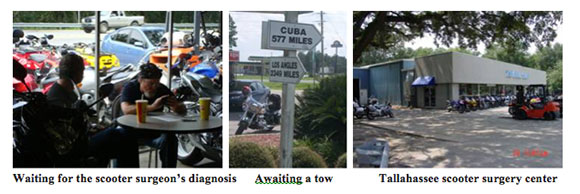
Copyright © 2017 From My Isle Seat
www.vicsocotra.com
Higher Education

(Panoramic View of the Naval War College campus at Newport, Rhode Island).
Willow was quiet that afternoon. It was a bit early for Old Jim to limp down the block for happy hour, and Mac Showers and I had were the only customers inside. A couple tables were full out on the patio, but the sultry August weather had everyone at a low ebb. If there were ceiling fans inside, the dust motes would have danced in the breeze. it would have been a setting out of any classic film noir movie. Mac was in an aloha shirt, no jacket, and I was still in my work clothes. We ere talking about the early 1960s, times that we overlapped in this world and which, on a good day, I vaguely recall. Behind the bar was Tex, the former Marine who stands about six two and has put on a little weight since he got out, but is always jovial and usually seems happy to see us. Tex was an interesting guy. He has some sort of a sinus problem that causes him to snort once in a while, and a cheerful indifference to the niceties of some social conventions. Which led to an unusual transaction at the bar one afternoon that will have to remain between the two of us.
But I was not there for commercial activity, regardless of how gratifying. I wanted to get through Mac’s time in the Y1 organization and get back to the Pacific, where I had some major questions to ask. So, without much ado, I launched right into it with my trusty pen in one hand and a glass of almost-Happy Hour white wine in the other. “So, with part of your organization colocated with NSA, you must have had a lot of interaction with The Fort.”
Mac nodded in agreement. “There were many interesting liaison activities that I conducted as Yl with NSA, some on very friendly and beneficial terms, not always at loggerheads with them, like the submarine program seemed to be. One at which I am not prepared to go into detail was the attempt between the Navy Research Laboratory and ONI on the one hand and NSA on the other to try to understand and capture the Soviet short-signal a burst transmission — which was just coming into use in the late ’50s, and surprising to say, we did succeed with great satisfaction in doing that. That was when I first met Dr. Gene Fubini, who NSA called in by NSA as a consultant to try to understand the electronic mechanics of the signal. I appreciated from the outset that Gene was a genius in these matters, and he and I subsequently became very close friends in many endeavors that the Navy had underway. He, of course, took up positions in the Pentagon — DDR&E, etc. — and I might comment that he was also is my neighbor, just around the corner when I was still in the house in North Arlington.”
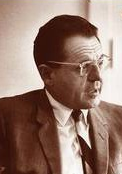
(Dr. Eugene Fubini, the legendary Navy electronic wizard).
“I remember the di-graph for the classification, Admiral. So, you were still doing SIGINT in Y1?”
“We did in the organization, yes, absolutely. You could not get away from it.”
“That makes sense, since Naval intelligence has always been focused to a large degree on being able to locate shipborne radars and communications. It was our bread and butter and still is.””Okay, let’s move on to my detachment from Yl in the summer of 1960, relieved by Captain John Q. Edwards, who has subsequently written in the Quarterly about some of his experiences in Yl. I was selected to attend the senior course at the Naval War College in Newport, which I did.
“I love military higher education,” I said with a laugh. “Were you a Commander or Captain?”
“I had been deep-selected for Captain, but I only made my number days before being detached from the Pentagon. I was happy to arrive at the War College in Newport as Captain rather than as a Commander, which was useful from the standpoint of getting better quarters and accommodations. I looked on my year at Newport as a sabbatical after all hard work and long Pentagon hours. It turned out not to be so relaxed, because I became so enamored with the academic community, and I got reintroduced to a delightful library where I could go and contemplate the things I had seen. The library at the War College is open 24 hours a day. You can go there any time to read or research, or whatever. Each student, of course, was assigned the writing of a term paper. My term paper was on the general subject of “Soviet Submarine-Launched Cruise Missiles,” which were just coming into the inventory and in testing testing stages at that time. So I did a research paper on those for which I fortunately got an outstanding grade. I had some help from my old shipmate Art Newell, who was the intelligence specialist assigned to the War College faculty at the time, and coincidently was also my faculty· advisor. But the War College turned out to be truly a delightful experience.”
“I never had to worry about earaly selection. But I agree. I felt the same way about the Industrial College when I finally got a chance to go to school. Who would have imagined getting full pay and allowances while getting your masters degree?”
“The War College was not a degree-granting institution then. They worked out something with the Salve Regina College across the road to accept the War College curriculum as meeting their standards for a degree later, but it didn’t exist then. Higher military education was certainly a change of pace for me and the family. We were at Newport when the Bay of Pigs raid occurred.”
“1961, right? That That would have been the Cuban Crisis period,” trying to get my recent history straight. “The Cuban Missile Crisis was in 1962. The Bay of Pigs was right after JFK came into office, which would have been January of that year.”
“Yes. I was at the War College at the time of the Bay of Pigs. John Edwards was in Yl, because he mentions some of this incident in his account. I also was at the War College when the two Brits defected.
“Burgess and McLean, right?”
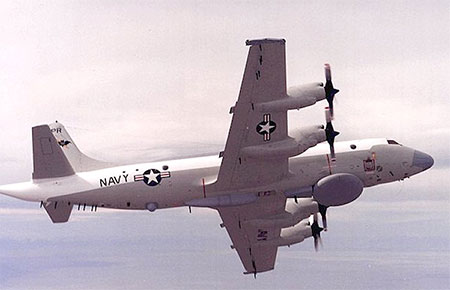
Mac gave me a thin smile. “At the time, I was absolutely astounded to read The New York Times about the Soviet accounts of the debriefings in Moscow after they arrived in Moscow. That was really the first time that U.S. and U.S./British SIGINT activities were openly made known to the Soviets, as far as we knew.”
“We seem only to keep secrets from the people who pay for them. The Soviets had moles everywhere, and there was not much they did not have. Down through the years, we have certainly had a lot of people willing to give things up to them, either out of ideology or for cash.” Mac nodded gravely.
“Yes, it was all printed for the general public. They were absolutely astounding accounts. I was sitting up in Newport reading about all this, knowing I was going back to the Pentagon to head “Y” Branch and deal with what had been exposed to the Soviets. Anyway, the year at Newport was interesting. That was the year that John Kennedy was elected. One of our speakers at the War College was Paul Nitze, who at that time was campaigning for John Kennedy. I remember his talk about naval activities and naval operations. During the question and answer period, there had just been an incident where a Soviet SIGINT trawler had attempted to recover a missile being tested off Cape Canaveral. And the question was asked of Paul Nitze, who was preaching the more aggressive nature of military operations that would come into being during a Kennedy Administration. One of the questions was, “If you were Secretary of the Navy, what would you have done about that SIGINT trawler that attempted to recover the missile?” And he shot back, “I would have sunk the son-of-a-bitch!” And he got a standing ovation. Two or three hundred students in the auditorium, very impressive then, and of course, Paul Nitze later did become Secretary of the Navy. I don’t recall him sinking any trawlers, though.”
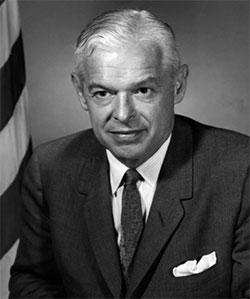
(The Honorable Paul Nitze as SECNAV).
“The OpNav Staff must have told him there was a State Department?.”
“”Right. Among other things. Anyway, on completion of my War College work, I was ordered back to the Pentagon to relieve Captain Fred Welden as head of 1Y Branch. I reported in August 1961 and was delighted to be there. I felt that I had finally arrived at the epitome of OPINTEL in the Navy and was in the billet I had long admired and sought after.
“This was in the D-ring on the fifth floor of the Pentagon?
Mac nodded. “The D-ring on the fifth floor. The area was blocked off at both the 7th and 8th corridors, I believe. We had an enclosed hallway in which we had the parts of “Y” Branch that were not at The Fort: Y-2, Y-3, and Y-4 .
“What did each of the groups do?” I asked, taking a sip of wine and letting the pen rest on the bar where it was safe.
“Well. Y-1, or the Naval Field Operational Intelligence organization was still at Fort Meade, under John Edwards. Y-2 was responsible for briefings to the Chief of Naval Operations….”
“What we knew as CNO Intelligence Plot. Jake tried to detail me there one time.”
Mac nodded, “We called it that, too. I’m trying to distinguish between Y-3 and Y-4.” His face was screwed up in thought. “Y-4 was ELINT and was responsible for the peripheral collection activities, mainly of the VQ squadrons- the electronic collection P-3 Orion aircraft. This was really the Washington contact point over the activities of the VQ squadrons, and Y-4 was mainly manned by aviators that had been in the VQ squadrons and understood the avionics of flying those airplanes. Y-3 then, I can’t recall. It might have been collection management.” \
“You had this whole empire?”
“Yes I did. The whole shooting match, and I should be able to recall. It seems to me that Y-3 had something to do with collection activities involving the U-2 because, on this tour of duty for the first time, I was briefed among other things on the U-2 operation and also, before the tour was over, on the advent of satellite operations. They were collecting photography of military installations in denied areas.”
“Which would have been useful before Gary Francis Powers was shot down over the Soviet Union. That is about as denied as you can get.”
Mac smiled. “That was why we moved things onto low earth orbit. Not that many Russians there in those days.”
“And now we get our rocket engines from them.”
“It is a strange world, isn’t it?” asked Mac as he contemplated his Virgin Mary.
Copyright 2017 Vic Socotra
www.vicsocotra.com
Life and Island Times: Eff-Ell-A
Their bikes had been grooving and gliding the past two days. They had made good time and covered beaucoup miles across the southwest desert emptiness. If the bikes had been their dancing partners, they would have said that they were cutting a rug like they used to say back in the 1920s. None of them were partial to the modern dance slang compliments like busting a move. It is big-time bad luck to associate the word bust with one’s motorcycle when you’re thousands of miles from home.
With their scooters two-step boogying to the road’s improvisational Cajun music, all the bikers had to do was point the way and keep themselves and the bikes and themselves fed and rested. They kept on smoking and spoking the roads.
They were sure that they had left their troubles firmly behind. Their 100 horse powered V-twin divas were lean and mean. All they needed were three more days to make it to the fourth and final corner. Just three more steps and they’d have gone door to door.
From New Mexico into Texas and Louisiana they’d been riding the rim of a great vacant southern highway. Howling on Texas crude high test, the motorbikes’ fire chased away each dawn’s chill air and fading half-moon. Their three bike formation was so knife-edge tight and imposing that big diesel trucks stayed away from rolling down their backs. Two consecutive days averaging over 620 miles each was their down payment on exiting this desert Big Empty. They couldn’t wait to hit that Florida border.
This day would take them from Baton Rouge to Pensacola Florida where the US Navy had located its aviation museum. Augustus and Marlow had a need to visit the old aluminum airframes that had occupied a significant portion of their military careers. After an afternoon visit, they highballed it to Tallahassee before the final two day push to Key West via Lake O and the Everglades.
This was the last day of significant slab time. They quickly finished off Louisiana, then Mississippi and Alabama. At a Florida rest stop, they were ambushed by the aromas of freshly mowed, sweet-smelling Bermuda grass and the Gulf’s warm salt waters. Marlow was back in his Eff-Ell-A!
After five hours and 300 miles, they entered the cool confines of the museum. As they wandered around the exhibits, they spent hours telling tales and swapping lies about young men and their flying machines. If their bespectacled eyes didn’t trick them, they spotted more than a few battle damage patches on the venerable birds’ fuselages from long ago wars in East Asia.
They spent an hour in the museum’s recreated Cubi Bar Café. The cafe was reconstructed using memorabilia from the Officers’ Club at Cubi Point Naval Air Station. For 40 years of deployments, squadrons and other units customarily presented a plaque or emblem to the Officers’ Club as gestures of thanks and remembrance. The Club closed in 1992 when the US Navy finally left the Subic Bay base complex in the aftermath of the Mount Pinatubo devastation. The recreation was chockfull of the best of the best. Before they ended this side trip down a nearly forgotten memory lane, they toasted the skills of those who caught the wire on the Cubi Point catapult in the “Red Horse Cat-House.”
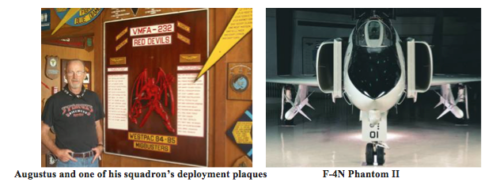
After exiting the museum into the humid Florida panhandle air, they pressed on another 200 miles to an overnight stay in the Sunshine State’s capitol city.
Copyright © 2017 From My Isle Seat
www.vicsocotra.com
Life and Island Times: Simply Slabbing
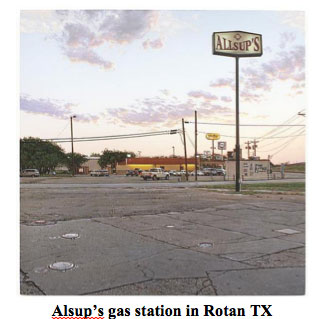
During the previous day’s wanderings, they had another near out-of-gas experience in the west
Texas outback along US 380. It seems that these desert Bible-belt, God-fearing folks don’t operate
their gasoline stations on the Lord’s Day.
Their engines-off coasting into a Rotan Texas gasoline and quickie mart station occasioned several
new candidate nicknames for Augustus and his less than a tenth of a gallon of gas remaining bike.
Gas Guzzler, Mileage Master and Most Excellent Estimator seemed too mundane, too ironic or
more than a bit untruthful. Later while they topped off their tanks for a last, speed-of-heat, slab
segment to the Fort Worth area, they settled on Gasturbator as his new moniker.
With this day in the book, Marlow had journeyed 35 days on this trip and over 10,000 miles. He
had ridden Wilma more than 35,000 miles since he picked her up in Scranton Pennsylvania 29
months earlier.
On Monday they slabbed eastward and then southward 500 miles to the next overnight location in
the Bayou state. They repeatedly rode through narrow rain-band showers that were the remnants of
Tropical Storm Faye.
After a long, hot and humid outing, they arrived with t-shirts fully drenched in sweat.
They were pleasantly surprised by an outstanding dinner at a local Baton Rouge fish house,
Parrain’s, that Steve had discovered during a State Department assignment to Louisiana for the
Hurricane Katrina recovery efforts in 2005.
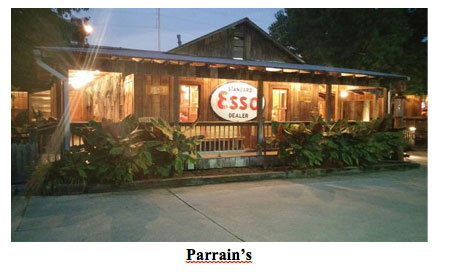
Copyright © 2017 From My Isle Seat
www.vicsocotra.com
Blue Ribbon Panels
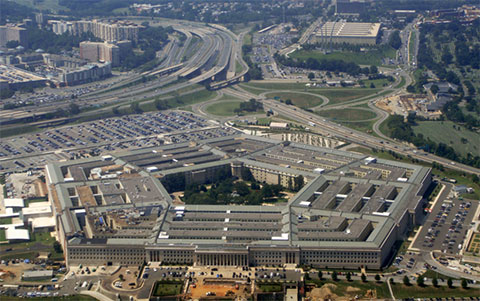
Willow was just starting to take on the energy of the post-work Happy Hour Crowd. Liz-with-an-S was behind the bar, and working some of the questions for admission to the Virginia Bar. She is already admitted to New York and New Jersey- but that wasn’t quite good enough to crash the protective gates of the Lawyers Lobby here. We were pulling for her to get out of Food and Beverage and get back to being an officer of the Court the way she had intended- and maybe whittle down some of the student debt that she had amassed getting through Law School.
I had given her a set of flash cards I found on the web to drill on likely questions she would encounter in the exam- and take a new direction in her professional life. In between tulip glasses of happy Hour White, of course.
Old Jim was seated in his usual place at the apex of the Amen Corner. He was a constant fixture at Willow, at least when he was not involved in a boycott resulting from overfamiliarity, since he lived with his bride Chanteuse Mary just down Utah Street and with his bum leg, it was just about the right distance for him to travel. Even Uncle Julio’s up the block was a little far to hike. Anything else- The First Down or The Front Page, for example- were a cab ride away, much less the bright lights of Clarendon, the next stop on the Orange Line route into town.
Mac was prompt and nicely turned out in a jacket and sport shirt. I had no idea what I wanted to cover in this chat. When we had talked about his time at Fort Meade with the Naval Field Operational Intelligence Office we had got to the point of talking about one of the first major controversies at the national level of the Intelligence Community- the amount of money we spend to do things like miss the collapse of the Soviet Union. That sort of thing.
But this was before the trauma of the Vietnam conflict, which I hoped to get to in the next few weeks. I picked up my pen, now that Liz-S had me set up with a full glass of wine and a ready supply of cocktail napkins. “OK,” I said. “You were just getting to the first of the big Blue Ribbon Panels in which you participated. I remember you mentioning the Schlesinger Panel, the Church and Pike Commissions and all the rest. What was this one called again?”
“It is a recurring phenomenon in the Government. Something happens, everyone agrees it looks bad, then they call in some smart people and make recommendation that may or may not be helpful. Early in my tour at NFOIO, our Director Admiral Frost became involved with what became known as the Robertson Committee,” said Mac. “Mr . Robertson was an Assistant Secretary of Defense — and was charged by the Secretary of Defense to find out what communications intelligence was costing the United States government.”
“That has got to be a huge amount,” I said. “The whole NSA and all the activities the Services had embedded in their structures. I doubt if anyone could track it all down.”
“Robertson tried. This was the beginning of serious budget concerns in the intelligence and the COMINT business. So the Robertson Commit.tee was formed of Army, Navy, Air Force — the intelligence agencies and the cryptologic agencies of Army, Navy, Air Force — and NSA, and it was monitored by State Department and CIA and other people in the government who used COMINT. It became a large committee that worked for several months to price out costs of COMINT, to find out where there might be duplication, where there might be wasted effort, where there might be gaps. Their ultimate outcome was to come up with the first consolidated cryptologic program and
in fact, still exists.”
“But this was before Vietnam. Before the major expansion of everything and they already were wondering what they got for their money?”
“!958, I think things really got rolling, or late in 1957. Shortly after reporting as chief of Yl in March 1957, Admiral Frost called me in to his office in the Pentagon to ask me to Bak-stop him as a member of the Robertson Committee. As Assistant Secretary of Defense, he had been charged by SECDEF to convene a group of authorities and over time to examine and price-out the total cost to the Defense Department of all the cryptologic activities then ongoing. Admiral Frost was a member of the group as the DNI, and I was his backup. He probably had backup from the Naval Security Group as well, since that is where the equities were located. It was a large committee: Army, Navy, Air Force, various elements of the Defense Department, the budget people, of course, and the Armed Forces Security Agency, or National Security Agency, which it probably was called by then. We even had State with at least observer status, the CIA, and the other elements of the government who were users of· the cryptologic product. It was a large committee, and it consisted of the committee of Principals and then there was a working group for those of us who were the backup would meet to do our spade work.”
“Sounds like the Deputy’s Committee where real work gets done. You never get anything effective with just the grownups there.”
“Well, we sat for several months, certainly the better part of a year. I don’t recall the full extent of it. but the result was the creation of the Consolidated Cryptologic Program (the CCP), which since then is still the cryptologic program that carries the budget program for all cryptologic activities in the Defense Department. In those days, it was managed then by the Director, Defense Research and Engineering within the Pentagon. DDR&E was the Pentagon point of contact for all cryptologic activities under the responsibility of the Secretary of Defense, and DDR&E was, in effect, the office of the SECDEF which was designated as being responsible for the activities of the National Security Agency. I mention this because it was the birth of the CCP and the first time that anyone had attempted to put the cryptologic budgets together into one package, which happened then and has continued since and has also been applied to other types of activities and programs in government.
I do recall that the total bill the magnitude of the program and it turned out to be an astounding figure. This surprised everybody. I don’t recall what it was at that time, but, when it was all put together and added up, it was an amazing number. That effort took a good deal of my time because this committee or the working group met in lengthy sessions at least weekly, if not more often, in the Pentagon. I was at Arlington Hall for the first nine months of that tour, so that was not too much of a dislocation, but, after we moved to Fort Meade in December 1957, this increased the commuting time and the commuting activities. I, however, lived in Arlington at that time so, if there were meetings to be attended in the Pentagon that were going to go all day or a good portion of the day, I could go from home to the Pentagon or I could go from Fort Meade to the Pentagon and then come home from there. So it wasn’t too inconvenient for me. That’s all I’m going to say on the Robertson Committee, since there were things that I still can’t talk about.”
Was there anything else you wanted to know about my time at NFOIO? I think we’ve talked about the rest of my tenure as Yl, or more formally OP-922Yl. I wrote about it for the Naval Intelligence Professionals, but that was probably before your time as editor.”
“I will track it down, Sir. Should be interesting reading with a little perspective.”
“The article I wrote pretty much covered the tour of duty there, including the organization and functions of the office, some of the things we did, and our relationships with the National Security Agency. I didn’t go into those relationships in detail because they might include some subjects that would still be classified. In fact, I know they would. In a classified session, there may be some things that would be worth reporting as a result of that - particularly our role in working with the National Security Agency.”
“Let me see what I can find regarding the article. If I have questions, I am sure we can sort it out over an Anchor Steam Ale and some Hapy Hour White.”
“I would be delighted. I just have to get the Doctors on the same sheet of music as Willow.”
Liz-S came down the bar with a flash-card. “Does Atkins v. Virginia strike any chords?” she asked. “The defense apparently relied on a single exculpatory witness for a capital murder case.”
Mac pursed his lips. “I think I actually remember that one,” he said. “No Blue Ribbon Panels, though.”
“No,” said Liz-S. “The question is about the execution of mentally retarded persons and whether it is “cruel and unusual punishment” prohibited by the Eighth Amendment.”
“It may be cruel,” said Mac. “But in my experience, it is hardly unusual.”
Copyright 2017 Vic Socotra
www.vicsocotra.com
Life & Island Times: Cheesy Motel
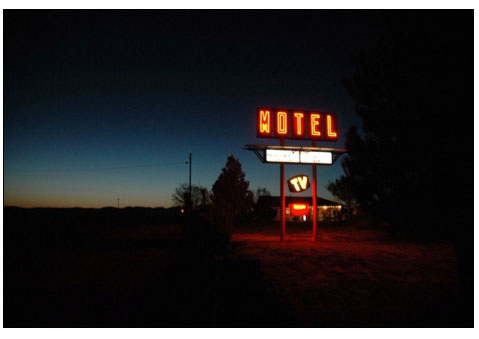
Editor’s note: Plain everyday observation and recording of yesterday’s long ago road roam came in dribs and drabs in the author’s journal over many years. Most was a kind of reporting, actually a remembering of the ‘seeing,’ ‘hearing’ and ‘feeling’ from that one night. It was carefully transcribed on found scraps of paper whenever the images, sounds and feelings reappeared and was then typed, more or less as it was seen, heard and felt.
I remember that night well in that cheesy motel
TV on low, we were dog tired and beat
They were selling death, crack cocaine, crystal meth
From the white Lincoln idling out by the street
There was no rhyme, no reason, and they weren’t in New York.
Junkies running from themselves, money and the flesh
Mistaking powder for love, these seekers with no song
And it still is for those of them left
Oh, most don’t get away, most die in a lousy way
Just throwing it all away to the ground
They can’t get away, it’s hell when they can’t pay
For making themselves numb, humming lil sweet songs
I remember that night well in that cheesy motel
We were headed to Eff-Ell-A
We watched with TV on low
Junkies fixing over suicide doors
There was no rhyme, no reason, and they weren’t in New York.
Junkies running from themselves, money and the flesh
Mistaking powder for love, these seekers with no song
And it still is for those of them left
I remember that night well at that cheesy motel
It was the summer of oh seven
The riders that night, trying to steer clear
And me, I was just trying to stay even
The riders left the next day
Closed their eyes, turned their back on the pain
They were still riding along on wild dreams
Racing the midnight trains as far they could see
Those they left behind had no dreams
Just nightly motel scoring schemes
Outside the rooms, desert wind ruefully rustles
Inside inward looking eyes growing darker in deep corners
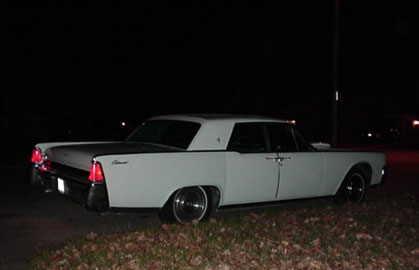
Copyright © 2017 From My Isle Seat
www.vicsocotra.com
Arrias on Politics: Watchers at the Gate
 Presidents are charged to defend the Constitution. Virtually all of them have stated at one time or another that their prime duty, which comes before all others, is to defend the nation. But defending the nation begins with recognition of threats, and then an acceptance of certain risks. For each president the acceptable level of risk will vary. Accordingly, the security policies of two presidents may vary widely, even though they may see the world in a similar light. Two presidents with substantially different views of the nation and the world, and different views of acceptable levels of risk, will develop substantially different security policies.
Presidents are charged to defend the Constitution. Virtually all of them have stated at one time or another that their prime duty, which comes before all others, is to defend the nation. But defending the nation begins with recognition of threats, and then an acceptance of certain risks. For each president the acceptable level of risk will vary. Accordingly, the security policies of two presidents may vary widely, even though they may see the world in a similar light. Two presidents with substantially different views of the nation and the world, and different views of acceptable levels of risk, will develop substantially different security policies.
Which is another way of saying: President Trump’s immigration policies are going to be different than President Obama’s. To not accept that is to deny reality. We can debate the process, and ask whether specific adjustments are legal, but to suggest that one president is “right” and the other “wrong” solely based on their stated concerns about immigration from a particular country is nonsensical. One sees it one way, one see it another; each will guard the “gate” differently; that shouldn’t surprise us.
That said, the law itself seems pretty clear:
“Whenever the President finds that the entry of any aliens or of any class of aliens into the United States would be detrimental to the interests of the United States, he may by proclamation, and for such period as he shall deem necessary, suspend the entry of all aliens or any class of aliens as immigrants or non-immigrants, or impose on the entry of aliens any restrictions he may deem to be appropriate.” (8 USC 1182 para f)
Well, what about the specifics of immigration? What is fair? Are these fair questions to ask of someone wishing to enter the US?
What is your name?
How old are you?
Are you married or single?
What is your occupation?
Are you able to read and write?
What country are you from?
What is your race?
Have you been in a prison, almshouse, or institution for care of the insane?
Are you a polygamist?
Are you an anarchist?
Are you deformed or crippled?
If they can’t answer the questions, or if certain information can’t be confirmed, or if they are clearly ill, is it fair to deny them entry? Perhaps hold them in quarantine, or turn them around and send them back to their country of origin?
Consider what two previous presidents said about immigration:
“[T]here are those in the immigrants’ rights community who have argued passionately that we should simply provide those who are [here] illegally with legal status, or at least ignore the laws on the books and put an end to deportation until we have better laws. … I believe such an indiscriminate approach would be both unwise and unfair. It would suggest to those thinking about coming here illegally that there will be no repercussions for such a decision. And this could lead to a surge in more illegal immigration. And it would also ignore the millions of people around the world who are waiting in line to come here legally. Ultimately, our nation, like all nations, has the right and obligation to control its borders and set laws for residency and citizenship. And no matter how decent they are, no matter their reasons, the 11 million who broke these laws should be held accountable.”
Or this:
“After years of neglect, this administration has taken a strong stand to stiffen the protection of our borders. We are increasing border controls by 50 percent. We are increasing inspections to prevent the hiring of illegal immigrants. And tonight, I announce I will sign an executive order to deny federal contracts to businesses that hire illegal immigrants.”
The questions above are from the standard questions asked of the 12 million people who entered the US through Ellis Island. The same questions were also asked of the quarter million who were stopped and sent back.
And the quotes? The first is from President Obama (2010), the second from President Clinton (1996).
Amidst all this seething anger it might be worth remembering that there are millions of people who want to come here, including citizens from the 3 largest Muslim populations: Indonesia, Pakistan, and India (none of whom were included in the 90 day suspension)). If you have a few minutes, do a little research on the internet and find how many people are waiting to move to those countries…
Copyright 2017 Arrias
www.vicsocotra.com
Why One
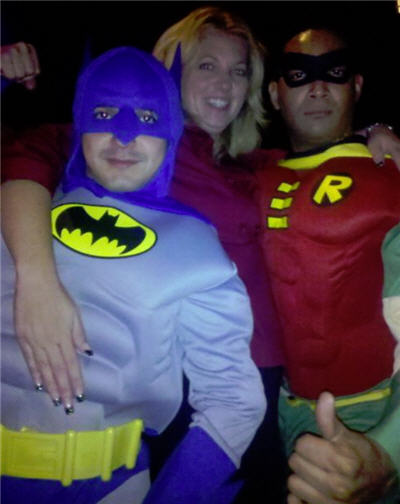
Peter was behind the bar, which means that this undated interview happened sometime before he either got fired or decamped downtown on his own volition. There is no one who could pour a more infuriating martini- the surface tension alone held the precious liquid in the glass, making it almost impossible to take the first sip with any grace. Normally I would use one of the small cocktail straws to draw down the level a bit and make in manageable, even if I had to hunch over the bar like Quasimoto to accomplish it. I miss Peter and whoever his little assistant was- I remember they dressed up as Batman and Robin on one of Tracey O’Grady’s spectacular Halloween parties. He was the first of the long-time bartenders to depart and make our little circle of barflies smaller. So, given the bar staff, I have to guess that this was a conversation in 2008 or 2009, back when Mac Showers and I were just getting rolling on the project.
He talked a lot about Arlington Hall Station, and it resonated with me, since the station is just across the street from the building where I live, and the cemetery just up the road contains the graves of many Japanese-Americans, which Mac explained was not unexpected, since the neighborhood was a nest of spies for years, since the Army took over the former girl’s school to make it their number one codebreaking installation, the book end to Navy’s occupation of the academy for young women on Nebraska Avenue.
I learned my lesson on Peter’s martinis, which were as potent as they were full, and was careful to stipulate the Happy Hour white wine, which in this case was a nice Flora Springs Napa Valley Chardonnay, 2004. At five bucks a glass, it was a good deal and kept us all coming back. Well, that might not have been the reason, since Jon-Without-an-H drank vodka and soda and Old Jim would not tolerate anything but Budweiser in a long-neck brown bottle. No accounting for taste.
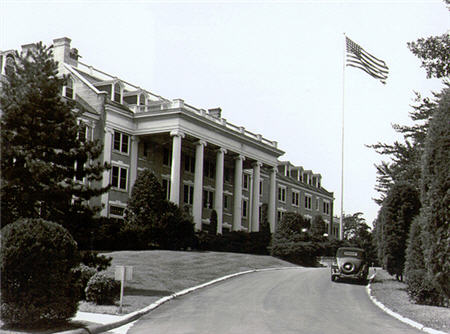
(Headquarters Building at Arlington Hall Station, Arlington, VA).
Confirming that it was a Napa wine are the color of the stains on the napkins on which I had taken notes. I honestly do not know how we got to taking about the Navy codebreakers who had moved into Arlington Hall after the war. The new and chilling relation with the Soviet Union brought the National Security Act of 1948, and a new consolidated organization to handle the COMINT missions of the military departments. The new organization was dubbed the Armed Forces Security Agency (AFSA), and was stood up in DoD on May 20, 1949.”
“I have visited the Key West White House where Mr. Truman worked on the Act. I think I would have just stayed down there. Was the process as confusing as I think it was?”
“Short answer is ‘Yes,'” Mac said. “In theory, the AFSA was to direct the communications intelligence and electronic intelligence activities of the military service signals intelligence units, which now included the brand new Air Force. In practice, the AFSA had little power, its functions being defined in terms of activities not performed by the service components. The answer, it appeared, was the creation of the National Security Agency, which sprang full-blown from the forehead of Walter Bedell Smith in a December 1951 memo to James B. Lay, Executive Secretary of the National Security Council. The memo observed that “control over, and coordination of, the collection and processing of Communications Intelligence had proved ineffective” and recommended a survey of communications intelligence activities. The proposal was approved on December 13, 1951, and the study authorized on December 28, 1951.”
“Aha!” I said triumphantly. “Our first Blue Ribbon Panel on intelligence failures!”
“Certainly not the last in my career,” Mac said with an ironic smile. “The report was completed by June, 1952. We called it the “Brownell Committee Report,” after the chairman. The thing was a survey of the history of U.S. communications intelligence activities. It came to the conclusion that there was a need for a much greater degree of coordination and direction at the national level.”
“Time for a name change, which is often the only way to move the deckchairs around on a sinking ship. The role of NSA was clearly going to extend far beyond the armed forces, and the facilities at Arlington Hall were not going to be adequate to the scope of the new mission.” At least that is what the histories say. I preferred just hearing it from a guy who was there.
We may have gotten to this since I had been relating a story that Louie, the former Chief of Staff at DIA, had told me about being a young analyst at Arlington Hall. When DIA was just starting and housed on the Arlington Hall campus, he worked in the Soviet Shop with a Navy Commander who had the irritating habit of removing his shoes when he came in the office, only putting them back on when the work day was done. When it came time for his to execute his Permanent Change of Station orders, Louie got even by nailing the empty shoes to the wooden floor of the ‘temporary’ office building. Mac was mildly amused, and mentioned that the windows on the Secure Compartmented Information Facility were drafty- the only time he had that problem with a SCIF. I asked him about his experiences at Arlington Hall.
“Well, I worked at Y-1 I worked in Y-1 between ’46 and ’48. Admiral Frost was the DNI when I came back to Washington from FIRST Fleet, and I had worked for him, of course, when he was a Captain. He was originally Y-1 in 1946, and I saw him frequently until I went to London. Admiral Frost, in the mean time, had gone off to do fleet duty or whatever. It was non-intelligence assignment, and then he returned after making admiral as the DNI. I 1 m not sure of the year. But he was the DNI when I returned to Washington in the spring of 1957 to take over Y-1. I found Y-1 much as I had left it, except enlarged. There were more people, different people, although some were the same. Maury Hellner and Ed Nielson were still there, Dr. Ed Haff was there. All of them had been hired into Y-1 as civilians; those three were civilians when I was there the first time, and they were still there. Maury stayed there during most of my tour, and Ed Nielson continued for a little while. Ed Haff had, I think moved over into the Pentagon into “F” branch just after I got there. But all those three people, who became high level analysts and well-recognized in ONI were first hired in naval intelligence service in Y-1 and cut their teeth doing Y-1 analysis. They did a creditable job all the time. The active duty officers assigned there were, of course, rotating, so the fact that I had been gone from Y-1 for seven years meant only the civilian cadre remained. Well, except for LCDR Barbara Conard- her married name was ‘Moore,’ if you want to check her out. But she too had other assignments while I was gone before returning. She was one of the original Y-1 group that we had at Nebraska Avenue in 1948.”
“I knew one of the women who worked there in the war. She wouldn’t talk about it, and freaked out that I knew about it, even though her work had been declassified decades before. Was she an intelligence officer by designation?”
“No. Barbara was a WAVE. And you don’t use that term anymore, I don’t believe. You call them “women officers.”
“They changed that to General Unrestricted Line- pronounced “GURL,” which seemed mildly sexist to me when I was in the personnel business, and trivialized the contributions of the WAVES. But now everyone can be a warfare specialist, even the Spooks. They even have a little badge to wear that says so.”
“I started as a Deck Officer, so I understand. But Barb was a Wave. She did not have a Special Duty- Intelligence designator. She had been on an assignment in New York and someplace else and then she came back to Y-1. I think she had been there about a year when I arrived back in 1957, and she stayed another year and then she received another assignment. But, other than that, a lot of the people were new. We had two or three Ensigns who were Naval Academy graduates but because of physical deficiencies, mainly eyesight, had been commissioned as intel and then had gone through Intelligence School. That program started when I was at the Intelligence School, and it had continued with three or four such officers a year. Some of them were on duty in Y-1, and some of them became career intel officers. That includes Admiral Bob Schmitt, who first worked in Y-1 as an Ensign, as did future DNI RADM Torn Brooks. And we moved to Fort Meade. The organization was larger, but the organizational structure that we had originally created still existed. There were some additional mission areas and simply more people assigned to do the increased volume of work. The products being put out were increased because of increased personnel, and the growing volume of raw material being provided.”
“What accounted for that, Sir? New collection systems coming on line?”
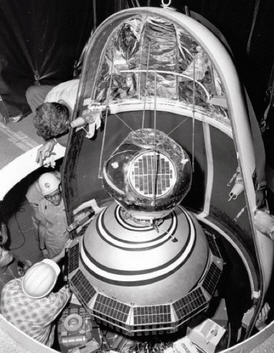
(GRAB Satellite, forerunner of orbital ELINT collection systems).
“Yes. There were land-based sensors that provided comprehensive HF/DF information and information on Soviet radar emissions and communications. Navy was the first of the Services to go to space with the 1960 launch of the Galactic Radiation and Background (GRAB) satellite, the cover name for the first of the ELINT collectors. POPPY was the follow-on system, which might have still been on orbit when you joined up. That was the mainstay of the U.S. Navy’s orbital ELINT collection capability for almost 15 years. It started out as a general search system whose mission was to map out the locations and capabilities of Soviet radar systems, but gained capability and data volume over time as new electronic systems were added to each launch.”
“It became a sea of data and now they are talking about it all floating around in a cloud. I am glad I no longer have to deal with it,” I said, sipping some of the Flora Springs.
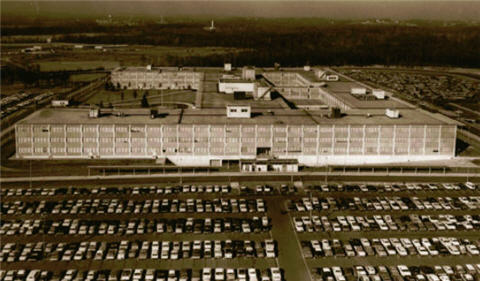
(NSA’s Operations Building #1, Fort Meade, MD).
“So it was not hard to fit right back into Y-1 when I returned, and we lived in North Arlington, so the commute was a breeze. The first issue I was confronted with after reporting was the fact that we were soon going to move to Fort Meade. I had no prior knowledge that NSA was building a headquarters building at Fort Meade and all that went with that. But when I arrived there in the spring of 1957, the construction at Fort Meade was well along. The headquarters building was due to be occupied later in the year. Many elements of NSA had already moved. When they created the NSA compound at Fort Meade, the first thing they constructed was the barracks for the Marine guards. These were three or four reinforced concrete, two-story buildings near the NSA headquarters building. Several elements of NSA were temporarily housed in these barracks buildings until the headquarters was completed. So, at the very beginning of my tour that Spring, we had to make liaison visits to some of the NSA elements at Fort Meade, and we went out on a few occasions and worked with the NSA people in these barracks buildings, which was rather disorganized and temporary, but nevertheless NSA was already operating on a split basis. So, we continued our planning for the move through the year, and, in December of 1957, we actually made our physical move. All the rest of NSA moved, and Y-1 moved along with it, in December 1957 and everybody took up full residence at the new headquarters building at Fort Meade at the same time. That opened a new era of activity with Y-1, which in the meantime had been re-designated the “Navy Field Operational Intelligence Office.” I always have to stop and think because of the difficulty of that title and the artificiality of it. I still to this day refer to the activity as Y-1, and I believe I always will. It’s an easier thing to say.”
“I totally agree about NFOIO’s name. But we had to acknowledge and use it, since they were the Gods of OPINTEL when I was out in the Pacific. What they said about the Soviet subs and merchant shipping was considered authoritative, and us Spooks out in the hustings were just the Junior Varsity.”
“That was the nature of the Ocean Surveillance Information System.”
“I am proud that I got to be part of the OSIS system,” I said, “We used to say that working at one of the Centers or Facilities was like trying to write a newspaper on the floor of the New York Stock Exchange.”
“Dave Rosenburg wrote a book about it called ‘The Admiral’s Advantage,’ said Mac. “He talked to me extensively on the origins and function of the system. We had the intelligence nodes of the system around the world- London, Rota, Pearl and Kami Seya. Sitting on top was Y1. You should be proud that you got to see one of the finest OPINTEL systems ever devised. But as to the NFOIO name, it was all Beltway politics and centers of gravity. At that time, Fort Meade was outside of what was defined as the metropolitan area, Washington, D.C. Fort Meade was geographically within the area of the Severn River Naval Command. I don’t know whether the Severn River Naval Command, as an administrative organization, still exists.
“Most of those commands have long gone away,” I said, wondering if there was a good time to step out and grab a smoke.
“I haven’t heard of the Severn River Command in years, but it was real, and led by the Superintendent of the Naval Academy. He was double-hatted to run the Naval Academy and the Severn River Naval Command. We fell within his geographical limits, so that was the reason that the activity was designated the field office of ONI located outside the Washington metropolitan area and why I was given additional duty orders to report to the Commandant of the Severn River Naval Command, who technic ally was my military superior.”
“And with whom you had very little business?”
“Almost nothing. I did go down to Annapolis to show we could play nice. I took Commander Ed Cummings with me, he was Y-lE, my production manager, and he was an Academy graduate. I’d never been to the Naval Academy before. I didn’t know my way around, so I figured I could use a ring-knocker to keep me on course.”
“Just to stay calibrated on this napkin, where were you in your career? Did you have your twenty years at that point?”
“Right on twenty in that tour, and just made Captain, so I had no thought about retiring. I was having too much fun. So, I took Ed with me to make my call on the Superintendent and to do all the necessary protocol niceties. And we did that; we had a nice discussion with him. We couldn’t tell him very much, because he wasn’t indoctrinated for our business, but he wasn’t overly inquisitive, so I’m sure he had many things of his own concern, and we were not very important to him. But he said he would designate one of his staff officers to be our point of contact for whatever business we might have. He designated Captain Fluckey who had already had some intelligence duty. I think that’s why he designated him.
“That would be “Lucky” Fluckey? The submariner who landed a sabotage party ashore in Japan to blow up a train during WWII?”
“And later Director of Naval intelligence. I knew him slightly at that time, and he was on duty in the Academy’s Electrical Engineering Department. So we continued our call and went over to see Captain Fluckey, and he was very receptive to us, very helpful, and said he would do anything that we needed help with. The only direct contact of a continuing nature we had with the Naval Academy was to transfer some funds from ONI for Severn River Naval Command, since we had to be paid by them, and they, of course, had no budget to cover our activity. So ONI transferred funds annually from the ONI budget to the Severn River Naval Command supply officer or comptroller, and he would issue the paychecks for our civilians.
“At Y1, were you working directly for the DNI? In terms of the content of your work, there was no intervening command? Did anyone at NSA check your work?”
“Absolutely not. We worked directly for the DNI, as we had been part and parcel of ONI. In fact, we still showed the Y-1 organization with the Y-1 designators on the ONI directory, the ONI Roster, with NFOIO simply put in parenthesis after my name. So, for all practical purposes, we were still ONI. But the important thing was, and this became significant later to other people, the important thing was that the personnel in Y-1 no longer counted against the headquarters establishment of OPNAV. It became significant because it led people to discover that you could create field activities and move them out of the immediate area, or out of the Pentagon, and thus reduce your OPNAV manpower ceiling while still having the organization in place, effective, and working for you. Since we were the first field activity of ONI, and we were created because of our geographic separation, it became a forerunner of what is now effect, field activities of ONI.”
“And you also provided a template for how other offices in the Pentagon to do such things?”
“Right,” he said with a slight grimace. “We are responsible for the sprawl. Little by little other activities were moved out of the Pentagon to the Hoffman Building in Alexandria and out to Suitland and were created as field activities of ONI, and subsequently NAVINTCOM was created to be the umbrella over all of these field activities representing the DNI.”
“Was being at Fort Meade any more of a handicap in getting your needs across and getting your support to the DNI?”
“No, it was no handicap because I continued to live in North Arlington. I started out each day from Arlington and returned to Arlington each evening, and, if need be, I could start my day in the Pentagon or finish my day in the Pentagon and not be grossly dislocated because I could simply change my schedule. In the beginning, most of our other officers also lived in the Virginia area, where we had all been in order to work at Arlington Hall. Some of the people relocated their households out to the Maryland countryside or to the Laurel vicinity. There were were no quarters available on the Post. Many people continued to live in Northern Virginia. I found it quite convenient to do so because I would, whenever necessary, spend a half a day in the Pentagon, either in the morning or in the afternoon or conceivably all day. But the wildest commute was that done by Captain Bill Hatch. He was determined to raise his family away from the big city and owned a farm out in Leesburg. He would drive to Arlington long before dawn and we would car pool to Ft. Meade.”
I gave a low whistle. “That might be the worst commute in Washington,” I said.
“And remember: it was before the Beltway, which didn’t get finished until 1964, and by that time I was on my way to Pearl Harbor again. Remind me to tell you about what the commuting was like one of these afternoons.”
“Yessir.” I asked Peter for the check, and counted myself lucky that I might have made my last drive to Fort Meade. At least on official Business, anyway.
Copyright 2017 Vic Socotra
www.vicsocotra.com
Life and Island Times: Road Room
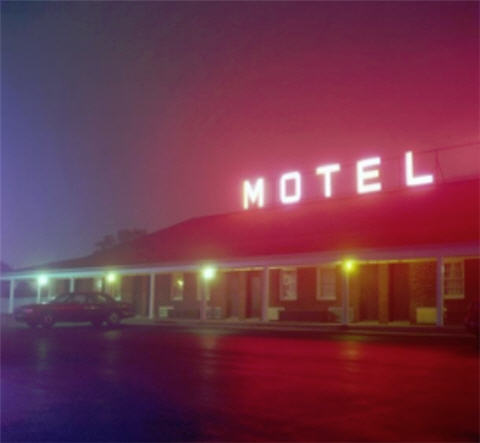
The room was one of those certain places where road pilgrims sometimes find themselves. They are located in an unseen world of lost opportunity, health and fortune. Most are found within two floors of artless, right-angled shelter that guests look at as a kind of oasis.
Modern America sparks from multiple collisions of its tradition and technology, tall towers and shanty towns, soaring wealth and crushing poverty. The bikers were approaching one of the towns which was slowly approaching the shanty-poverty end of this spectrum.
The sign was located close to the street in the middle of a short strip of small businesses. Signs said that dollar stores, pawn shops and national retail stores had come and gone. It had likely been a nice, upcoming little neighborhood — forty, fifty years ago. It now felt a lot like the people who currently lived there — tired and in desperate need of attention. It was getting dark and time to choose a spot to stay for the night.
The motel was smallish and reflected a woman’s touch, just the slightest bit girly. Everything was worn, humble, but maintained. Its red neon sign glowed: MOTEL.
On the clerk’s counter, there were a mess of bills as well as red notices for phone, electric, water as well as court orders to appear. All were sorted for the intended recipient’s room.
With space for the night secured, the riders walked outside and smelled a grim future-less dust in the air.
Inside the room: two chairs and a table. On the table, a phone; on the chairs, dirty clothes. Windows faced the parking lot. On the lot, kids; against the window, west winds. This was an abstraction, a painted summary, but children, innocent, unsuspecting, ran about outside, and the wind felt dry and hot on their cheeks. The riders inside the air conditioned room stirred not, their cycles’ powerful engines, in the spot outside the room window, clicked as their engines cooled.
In the motel room, a fuzzy rotary dial tuned TV blared into the middle of the country.
The crummy carpet beneath their feet was stiff, but it was the stiffness that helped hold some room residents upright — especially if they had had too much to drink.
It was a dirt-cheap motel room twenty miles away from any city of size. It looked pretty on the surface. Its most memorable feature was a white, antique Lincoln Continental parked in the lot, which was bathed by the mid-1950s neon sign’s soft red glow.
The Lincoln wasn’t there to ferry guests to a church picnic the next day. The Continental’s driver was selling snort-able pleasure powder.
At first, the place was peaceful.
Then night fell.
The kids who played in parking spaces went back indoors when the sun went down. A couple of meth heads took their place. Some guests visited that vintage Continental, while others muttered curses about lawlessness.
A few times that night, muffled screams could be heard. The bikers couldn’t be sure what was going on, but it sounded like someone was getting their ass whupped.
A deranged veteran in the parking lot serenaded guests with an unwanted freestyle rap about having “PSTD from a war that I didn’t ask for.”
Occupants looked weathered — old and decrepit long before their time.
Junkies multiplied as the clock ticked past midnight. The bars must have closed.
This motel might have been a nice place long ago.
All most of its residents really wanted was to find a way back home
It took effort to see, let alone assemble, the sad ugliness of this place.
Copyright © 2017 From My Isle Seat
www.vicsocotra.com
